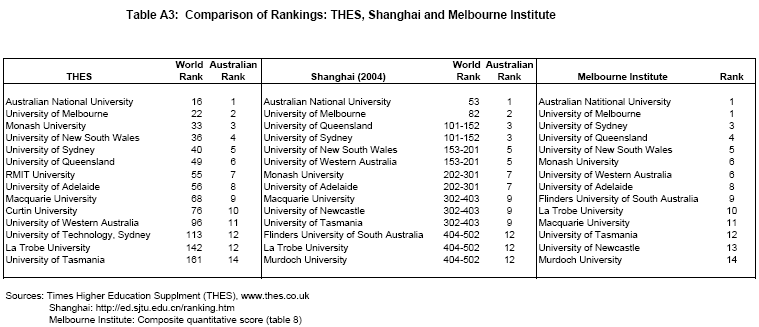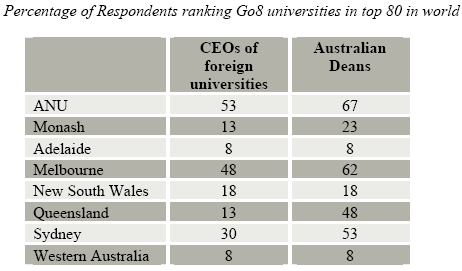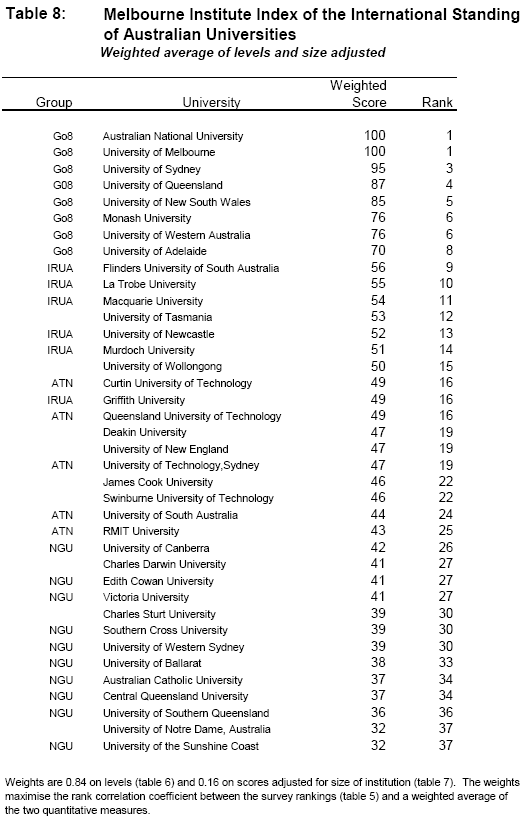 A Local
Assessment of
The International Standing of Australian
Universities. (November 24, 2004)
A Local
Assessment of
The International Standing of Australian
Universities. (November 24, 2004)
|
News & Views item - November 2004 |
![]()
 A Local
Assessment of
The International Standing of Australian
Universities. (November 24, 2004)
A Local
Assessment of
The International Standing of Australian
Universities. (November 24, 2004)
Following the second annual release this past August of Shanghai Jiao Tong University's listing of the world's top 500 research universities and last month's assessment of the world's top 200 universities by The Times Higher Eduction Supplement, the Melbourne Institute of Applied Economic and Social Research of the University of Melbourne today released a twenty-seven page study authored by professorial fellow Ross Williams, and research fellow Nina Van Dyke.
In contrast to the two earlier studies Williams and Van Dyke give precise rankings relative to one another for Australia's 38 public universities, and in addition position those they rank as the top 14 relative to the rankings given them by the other two evaluations.
Although the authors are at pains to demonstrate that their methodology of assessment is more objective than the previous studies, and places less weight on the research activities of the institutions, it shows nevertheless a high correlation with the other two particularly the Shanghai Jiao Tong University's listing.
Williams and Van Dyke describe their approach in an article published in today's Australian Higher Education Section:
In creating the Melbourne Institute Index of International Standing of Australian Universities, we combined the survey data with quantitative performance data. In the methodology we addressed two of the main criticisms of other international comparisons. The first criticism is that in combining various attributes the variables used are too heavily weighted towards research activity. In our index we extend the coverage to include teaching and research training.
The second criticism of traditional studies is that the weights used to combine attributes are arbitrarily chosen by the researchers. We dealt with this by asking respondents to our surveys to place weights on groups of attributes, using as the criterion international standing. Remarkably, overseas chief executives and Australian deans placed about the same weights on each of our groups of attributes:
* International standing of academic staff (40 per cent).
* Quality of postgraduate programs (16 per cent).
* Quality of undergraduate intake (11 per cent).
* Quality of undergraduate program (14 per cent).
* Resource levels (11 per cent).
* Peer opinion (8 per cent).
Two paragraphs in their article sum up the rationale for their effort.
The international standing of Australian universities has become a matter of considerable national debate, often related back to funding issues. Does it matter if no or few Australian universities are ranked highly?
It matters because without some universities with good international reputations it is difficult for a country to attract top researchers from abroad, including expatriates. It matters because without internationally competitive institutions the country cannot attract the best students from abroad - market research shows that many of the brightest students in Asia still have a preference for the US and UK over Australia, which may in part be due to lack of information about the standing of Australian universities. It matters because global employers prefer students from more highly ranked institutions.
Following are three of the tables provided by Williams and Van Dyke in their paper:


The relative positions of Australia's 38 public universities.
Go8 = The Group of Eight;
IRUA = Innovate Research Universities Australia;
ATN = Australian Technology Network
NGU = New Generation Universities

The full release of information by the Melbourne Institute of Applied Economic and Social Research is available at:
http://www.melbourneinstitute.com/austuniv/austuniv.html